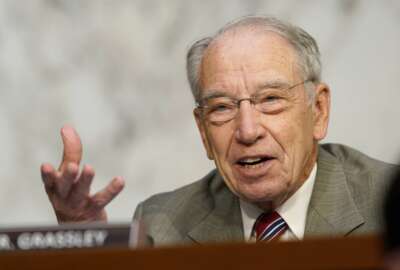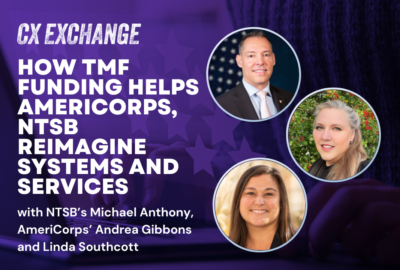Hubbard Radio Washington DC, LLC. All rights reserved. This website is not intended for users located within the European Economic Area.
On Air: Federal News Network
Trending:
Agencies taking the ‘Burger King’ approach to strategic reviews
OMB is giving agencies a lot of latitude to figure out how best to meet key parts of the Government Performance and Results Act Modernization Act of 2010. NASA,...
wfedstaff | April 17, 2015 7:09 pm
Like the fast food chain Burger King’s motto, agencies are having it their way — when developing their strategic review processes. The Office of Management and Budget is giving agencies a lot of latitude to figure out how best to meet key parts of the Government Performance and Results Act Modernization Act of 2010 (GPRAMA).
GPRAMA required agencies to develop annual reviews and ratings of programs, and then publish them. This was the first year agencies both created and published those strategies, and now they are doing the reviews and rankings.
Lisa Danzig, OMB’s associate director for personnel and performance, said it’s still early in the review process, but all signs point to good things coming from them.
“I see three parts to the strategic reviews. One piece of it is assessing progress. That’s where we often talk about whether you are red, yellow or green, or we’ve used language here about significant challenges or noteworthy progress, and how well we are doing. That’s kind of the very first step of diagnostic of how well we are doing,” Danzig said Wednesday during an event sponsored by the National Academy of Public Administration in Washington. “The second step, then, is informing decision making, with an expectation that we will do a little bit of that in this 2014 cycle, but we are really expecting that to mature over time. So I think that’s the second stage of this. How does it inform our long-term strategies? How does it inform budget formulation, legislative strategies, ideas or opportunities to incorporate better evidence and research demonstration? That’s where I think there is a lot of richness. Then I think ultimately the third piece of this is how to take action to make improvements.”
NAPA and OMB jointly released a new report on getting more from strategic reviews. The report highlighted current steps so far at agencies such as the Housing and Urban Development or the Department of Labor, as well as highlighted issues or challenges to improve and build capacity for these processes.
In the short term, OMB will conduct these reviews of plans and goals through July in preparation for the fiscal 2016 budget request. Danzig said the review meetings usually include eight to 10 senior executives, including deputy secretaries, assorted CXOs and program folks.
More flexibility in the design
Conducting program reviews is not new for most of the government. But the difference this year is OMB didn’t prescribe the approach. In fact, Danzig says it will take agencies two to three years to mature the review processes.
Danzig said too often agencies get overly caught up in the process and not in the overall goal of making improvements across program areas.
Beth Robinson, the CFO at NASA, said they meet monthly to go over their programs and cycle through every program four times a year.
“This is one of the few performance exercises that we were asked to do something in a less perspective way, and we could actually tailor it to our agency’s needs,” she said. “That was very welcome by the agency. The agency was like, ‘OK, we really want to take this as a communication tool outside of our agency.'”
Robinson said during the early days of GPRA, it wasn’t always this way. She said there was a time when one of the appropriations subcommittees would tell the agency to put all its budget data on white paper and all its performance information on green paper. The congressional staff members would tear out the green paper because they didn’t understand the performance data.
“I think we’ve come a long way since then in using it as a communications tool. I think people are very excited to be able to do something in the spring where there is communication early on with OMB and others on what the challenges we face are,” Robinson said. “It’s an early indication of what we will bring forward as our solution set in September, so I think the timing of it was very welcome.”
Robinson said usually the performance and budget data are sent to OMB all at once and there’s no way anyone can make heads and tails over what’s really going on because of the volume of information.
A framework that fits their mission
The National Science Foundation approached the reviews called for under the GPRA Modernization Act in a different way than ever before.
Martha Rubenstein, the CFO of NSF, said too often in the past, the frameworks that OMB wanted agencies to use just didn’t work for how they meet their mission.
Rubenstein said this approach was a lot better and different.
“The framework was very loose and we looked at our strategic objectives and, first of all, the deputy PIO and I went around to every single leader in the agency and personally sat down with them to explain what we thought we would do. We explained where their role would be and asked them to look at the strategic objectives and pick what they were interested in doing,” she said. “We got a lot of top level buy-in. People were picking things that interested them. I think that was really key. We didn’t say, before GPRA, it was always like, ‘We need to answer this question.’ We told them, ‘What are the questions you want to answer?’ We’ll help you find what data and evidence does exist and we’ll help you do the grunt work to answer those questions.”
Rubenstein said they are trying to answer questions that are more introspective about how the NSF does its business. Rubenstein said the high-priority goals laid the initial foundation for the strategic reviews.
In fact, she said the program people run these reviews with help from the performance office to provide data and do other research on the programs and areas.
End result is better decisions
Danzig said just running better or less prescriptive reviews is the means to the end. The real goal is to make sure agencies use their strategic plans, rankings of programs and all that data to make better decisions.
She said by giving agencies more leeway, the hope is they don’t run out of steam during the diagnostic stage and get to the process improvement stage. Traditionally, Danzig said agencies tend to spend too much time developing their processes and not enough time making changes based on the information gleamed from the analyses.
“We don’t often get a chance to look at how well we’re doing across an objective outcome. We often are looking at individual programs. We are looking at individual budgets, or even individuals organizationally and how they are structured,” she said. “But we don’t look at how well are we doing at HUD to reduce discrimination in housing. That’s a broad question. How do you even measure that? How do we assess that collectively across all of HUD’s programs?”
Danzig was the former performance improvement officer at HUD, where she worked on several high-priority initiatives, including reducing homelessness among veterans. Danzig came to OMB in February.
“We had 22 different programs that contributed to rental housing and one way to really aggregate the impact of that,” she said. “I think these strategic reviews have been tremendous in helping everyone step back. There were existing processes structured around the budget structure or organizational structure, but not around these macro questions, and it was really helpful to ask this macro question.”
At NASA, Robinson said they are trying to create a link between their budget and their strategic plans.
“What we’ve been really trying to do is educate the people to the tool they have been given, and it was beautiful with this exercise because it came at a great time,” she said. “I remember one of our lead persons leaning over to me and he was like, ‘Wow, this was really connected to what our budget is going to be and the decisions. We just made a priority decision here.”
Robinson said linking the strategic priorities to the budget is part of how NASA is building momentum for these processes.
“You use it as a tool, as a focus mechanism and the fact that the agency has said these are the top two things we are going to fix,” she said. “If nothing else in our budget, we are going to do these two.”
Robinson added that the key is the follow through by the program and agency executives once that linkage is made.
Keeping to the roadmaps
At the NSF, Rubenstein said they are trying to learn how best to use their data, and if they can’t or if it’s not valuable, can the agency stop collecting it?
One challenge is ensuring agencies stay in the strategic realm and not fall into the easier tactical side.
Robinson said NASA is using roadmaps to stay on track, both strategic and IT roadmaps. She said the space agency, however, is aware that roadmaps tend to get old quickly so the management must ensure long-term plans are updated more often.
Danzig said the extent of the success and impact of strategic reviews is unclear so far, but she will have a better idea of how this approach is both taking hold and helping to make decisions for the 2016 budget request later this summer.
And of course, Danzig and others will be able to gauge the reaction from Congress if they are meeting the spirit and intent of the GPRA Modernization Act law.
RELATED STORIES:
Federal Drive: Brenna Isman, National Academy of Public Administration
Data to drive 2016 discretionary budget decisions
Agency collaboration founded in personal relationships
One year later: Experts weigh in on GPRA modernization
Copyright © 2024 Federal News Network. All rights reserved. This website is not intended for users located within the European Economic Area.
Jason Miller
Jason Miller is executive editor of Federal News Network and directs news coverage on the people, policy and programs of the federal government.
Follow @jmillerWFED





